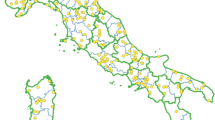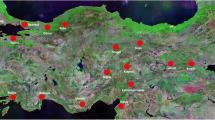Abstract
Viruses can have devastating effects and cause epidemics in honey bee (Apis mellifera) colonies. Black queen cell virus (BQCV), which is one of the most common honey bee viruses, affects queen bee larvae and their pupae. This study provides information on the dynamics of BQCV infection in honey bees, using molecular diagnostics to investigate the effects of other pathogens and seasonal patterns that are considered relevant to the epidemiology of BQCV. The results showed a relatively high prevalence of the viruses studied. The prevalence of BQCV, acute bee paralysis virus, and deformed wing virus in worker bees was found to be 90%, 62%, and 84%, respectively. The prevalence of BQCV was 58% in larvae and pupae. Furthermore, the prevalence of Nosema ceranae was 46% in worker bees. Statistical analysis showed possible combined effects of BQCV and other examined viruses in terms of infection dynamics, while BQCV did not show seasonal variation. The BQCV isolates detected in this study were placed in a phylogenetic framework using sequence data from comprehensive sampling in previous studies. The analysis suggested that the Turkish strains of BQCV clustered together with Australian and European strains and consisted of homogeneous populations that had evolved from a common ancestor. This is the first report of BQCV infection dynamics in honey bees in Turkey.




Similar content being viewed by others
References
Akkaya H, Alkan S (2007) Beekeeping in Anatolia from the Hittites to the present day. J Apic Res 46:120–124. https://doi.org/10.1080/00218839.2007.11101378
Venturini E, Drummond FA, Hoshide AK, Dibble AC, Stack LB (2017) Pollination reservoirs in lowbush blueberry (Ericales: Ericaceae). J Econ Entomol 110:333–346. https://doi.org/10.1093/jee/tow285
Remnant E, Shi M, Buchmann G, Blacquière T, Holmes E, Beekmann M, Ashe A (2017) A diverse range of novel RNA viruses in geographically distinct honey bee populations. J Virol 91:1–19. https://doi.org/10.1128/JVI.00158-17
McMenamin AJ, Flenniken ML (2018) Recently identified bee viruses and their impact on bee pollinators. Curr Opin Insect Sci 26:120–129. https://doi.org/10.1016/j.cois.2018.02.009
Martinello M, Baratto C, Manzinello C, Piva E, Borin A, Toson M, Mutinelli F (2017) Spring mortality in honey bees in northeastern Italy: detection of pesticides and viruses in dead honey bees and other matrices. J Apic Res 56:239–254. https://doi.org/10.1080/00218839.2017.1304878
Ellis JD, Evans JD, Pettis J (2010) Colony losses, managed colony population decline, and Colony Collapse Disorder in the United States. J Apic Res 49:134–136. https://doi.org/10.3896/IBRA.1.49.1.30
vanEngelsdorp D, Meixner MD (2010) A historical review of managed honey bee populations in Europe and the United States and the factors that may affect them. J Invertebr Pathol 103:S80–S95. https://doi.org/10.1016/j.jip.2009.06.011
Genersch E, Aubert M (2010) Emerging and re-emerging viruses of the honey bee (Apis mellifera L.). Vet Res 41:54. https://doi.org/10.1051/vetres/2010027
Locke B, Forsgren E, Fries I, de Miranda JR (2012) Acaricide treatment affects viral dynamics in Varroa destructor-infested honey bee colonies via both host physiology and mite control. Appl Environ Microbiol 78:227–235. https://doi.org/10.1128/AEM.06094-11
de Miranda JR, Bailey L, Ball BV, Blanchard P, Budge G, Chejanovsky N, Chen YP, Gauthıir L, Genersch E, de Graaf D, Ribière M, Ryabov E, de Smet L, van der Steen JJM (2013) Standard methods for virus research in Apis mellifera. J Apic Res 52:1–56. https://doi.org/10.3896/IBRA.1.52.4.22
Kevill JL, Highfield A, Mordecai GJ, Martin SJ, Schroeder DC (2017) ABC assay: method development and application to quantify the role of three DWV master variants in overwinter colony losses of European honey bees. Viruses 9:314. https://doi.org/10.3390/v9110314
Cirkovic D, Stevanovic J, Glavinic U, Aleksic N, Djuric S, Aleksic J, Stanimirovic Z (2018) Honey bee viruses in Serbian colonies of different strength. Peer J 6:e5887. https://doi.org/10.7717/peerj.5887
McMahon DP, Natsopoulou ME, Doublet V, Fürst M, Weging S, Brown MJ, Gogol-Döring A, Paxton RJ (2016) Elevated virulence of an emerging viral genotype as a driver of honeybee loss. Proc R Soc Lond B 283(1833):20160811. https://doi.org/10.1098/rspb.2016.0811
Galbraith DA, Fuller ZL, Ray AM, Brockmann A, Frazier M, Gikungu MW, Losyev O (2018) Investigating the viral ecology of global bee communities with high-throughput metagenomics. Sci Rep 8:8879. https://doi.org/10.1038/s41598-018-27164-z
Yang B, Peng G, Li T, Kadowaki T (2013) Molecular and phlylogenetic characterization of honey bee viruses, Nosema microsporidia, protozoan parazites and parasitic mites in China. Ecol Evol 3:298–311. https://doi.org/10.1002/ece3.464
Shumkova R, Neov B, Sirakova D, Georgieva A, Gadjev D, Teofanova D, Radoslavov G, Bouga M, Hristov P (2018) Molecular detection and phylogenetic assessment of six honeybee viruses in Apis mellifera L. colonies in Bulgaria. Peer J 6:e5077. https://doi.org/10.7717/peerj.5077
Abou-Shaara H (2019) Highlights on the genetic relationships between some honey bee viruses using various techniques. J Appl Biotechnol Rep 6:15–19. https://doi.org/10.29252/JABR.06.01.03
Mondet F, de Miranda JR, Kretzschmar A, Le Conte Y, Mercer A (2014) On the front line: quantitative virus dynamics in honeybee (Apis mellifera L.) colonies along a new expansion front of the parasite Varroa destructor. PLoS Pathog 10:e1004323. https://doi.org/10.1371/journal.ppat.1004323
Tentcheva D, Gauthier L, Zappulla N, Dainat B, Cousserans F, Colin ME, Bergoin M (2004) Prevalence and seasonal variations of six bee viruses in Apis mellifera L. and Varroa destructor mite populations in France. Appl Environ Microbiol 70:7185–7191. https://doi.org/10.1128/AEM.70.12.7185-7191.2004
Kojima Y, Toki T, Morimoto T, Yoshiyama M, Kimura K, Kadowaki T (2011) Infestation of Japanese native honey bees by tracheal mite and virus from non-native European honey bees in Japan. Microb Ecol 62:895–906. https://doi.org/10.1007/s00248-011-9947-z
D’Alvise P, Seeburger V, Gihring K, Kieboom M, Hasselmann M (2019) Seasonal dynamics and co-occurrence patterns of honey bee pathogens revealed by high-throughput RT-qPCR analysis. Ecol Evol 9(18):10241–10252. https://doi.org/10.1002/ece3.5544
Murray EA, Burand J, Trikoz N, Schnabel J, Grab H, Danforth BN (2019) Viral transmission in honey bees and native bees, supported by a global black queen cell virus phylogeny. Environ Microbiol 21:972–983. https://doi.org/10.1111/1462-2920.14501
Oğuz B, Karapinar Z, Dincer E, Değer MS (2017) Molecular detection of Nosema spp. and black queen-cell virus in honeybees in Van Province, Turkey. Turk J Vet Anim Sci 41:221–227. https://doi.org/10.3906/vet-1604-92
Muz D, Muz MN (2018) A molecular epidemiological study of black queen cell virus in honeybees (Apis mellifera) of Turkey: the first genetic characterization and phylogenetic analysis of field viruses. Apidologie 49:89–100. https://doi.org/10.1007/s13592-017-0531-5
Çağirgan AA, Yazici Z (2021) The prevalence of seven crucial honeybee viruses using multiplex RT-PCR and their phylogenetic analysis. Turk J Vet Anim Sci 45:44–55. https://doi.org/10.3906/vet-2004-139
Chantawannakul P, Ward L, Boonham N, Brown MA (2006) Scientific note on the detection of honeybee viruses using real-time PCR (TaqMan) in varroa mites collected from a Thai honeybee (Apis mellifera) apiary. J Invertebr Pathol 91:69–73. https://doi.org/10.1016/j.jip.2005.11.001
Benjeddou M, Leat N, Allsopp M, Davison S (2001) Detection of acute bee paralysis virus and black queen cell virus from honeybees by reverse transcriptase PCR. Appl Environ Microbiol 67(5):2384–2387. https://doi.org/10.1128/AEM.67.5.2384-2387.2001
Gauthier L, Tentcheva D, Tournaire M, Dainat B, Cousserans F, Colin ME, Bergoin M (2007) Viral load estimation in asymptomatic honey bee colonies using the quantitative RT-PCR technique. Apidologie 38(5):426–435. https://doi.org/10.1051/apido:2007026
Martín-Hernández R, Meana A, Prieto L, Salvador AM, Garrido-Bailón E, Higes M (2007) Outcome of colonization of Apis mellifera by Nosema ceranae. Appl Environ Microbiol 73:6331–6338. https://doi.org/10.1128/aem.00270-07
Edgar RC (2004) MUSCLE: multiple sequence alignment with high accuracy and high throughput. Nucleic Acids Res 32:1792–1797. https://doi.org/10.1093/nar/gkh340
Tamura K, Stecher G, Kumar S (2021) MEGA 11: molecular evolutionary genetics analysis version 11. Mol Biol Evol. https://doi.org/10.1093/molbev/msab120
Tamura K (1992) Estimation of the number of nucleotide substitutions when there are strong transition-transversion and G + C-content biases. Mol Biol Evol 9:678–687
Al Naggar Y, Paxton RJ (2020) Mode of transmission determines the virulence of black queen cell virus in adult honey bees, posing a future threat to bees and apiculture. Viruses 12:535. https://doi.org/10.3390/v12050535
Brettell LE, Riegler M, O’Brien C, Cook JM (2020) Occurrence of honey bee-associated pathogens in Varroa-free pollinator communities. J Invertebr Pathol 171:107344. https://doi.org/10.1016/j.jip.2020.107344
de Miranda JR, Genersch E (2010) Deformed wing virus. J Invertebr Pathol 103:S48–S61. https://doi.org/10.1016/j.jip.2009.06.012
Chanpanitkitchote P, Chen Y, Evans JD, Li W, Li J, Hamilton MC, Chantawannakul P (2017) Acute bee paralysis virus occurs in the Asian honeybee Apis cerana and parasitic mite Tropilaelaps mercedesae. J Invertebr Pathol 152:131–136. https://doi.org/10.1016/j.jip.2017.11.009
Chauzat M, Higes M, Martín-Hernández R, Meana A, Cougoule N, Faucon J (2007) Presence of Nosema ceranae in French honey bee colonies. J Apic Res 46:127. https://doi.org/10.1080/00218839.2007.11101380
Nazzi F, Brown SP, Annoscia D, Del Piccolo F, Di Prisco G, Varricchio P, Pennacchio F (2012) Synergistic parasite pathogen interactions mediated by host immunity can drive the collapse of honeybee colonies. PLoS Path 8(6):e1002735. https://doi.org/10.1371/journal.ppat.1002735
Tsevegmid K, Neumann P, Yanez O (2016) The honey bee pathosphere of Mongolia: European viruses in Central Asia. PLoS One 11(3):e0151164. https://doi.org/10.1371/journal.pone.0151164
Genersch E, von der Ohe W, Kaatz H, Schroeder A, Otten C, Büchler R, Berg S, Ritter W, Mühlen W, Gisder S (2010) The German bee monitoring project: a long term study to understand periodically high winter losses of honey bee colonies. Apidologie 41:332–3352. https://doi.org/10.1051/apido/2010014
Strauss U, Human H, Gauthier L, Crewe RM, Dietemann V, Pirk CW (2013) Seasonal prevalence of pathogens and parasites in the savannah honeybee (Apis mellifera scutellata). J Invertebr Pathol 114:45–52. https://doi.org/10.1016/j.jip.2013.05.003
Tapaszti Z, Forgách P, Kovágó C, Topolska G, Nowotny N, Rusvai M, Bakonyi T (2009) Genetic analysis and phylogenetic comparison of black queen cell virus genotypes. Vet Microbiol 139:227–234. https://doi.org/10.1016/j.vetmic.2009.06.002
Acknowledgments
A part of this work, including BQCV prevalence and phylogenetic analysis, was presented at the 14th National Veterinary Microbiology Congress (VETMİK 2020).
Funding
This study was funded by the Scientific Research Projects Commission of Selcuk University (SU-BAP) (Project Code: 19401138).
Author information
Authors and Affiliations
Contributions
Conceptualization, investigation, and methodology: Oguzhan Avci, Mustafa Emin Oz, and Muge Dogan. Resources and funding acquisition: Oguzhan Avci. Formal analysis and data curation: Oguzhan Avci, Mustafa Emin Oz, and Muge Dogan. Writing – orginal draft preparation: Oguzhan Avci and Mustafa Emin Oz. Writing – review and editing: Oguzhan Avci and Muge Dogan. All authors read and agreed to the final version of the manuscript.
Corresponding author
Ethics declarations
Conflict of interest
The authors have no conflicts of interest to declare that are relevant to the content of this article.
Ethical approval
All procedures used in this study were implemented according to animal welfare regulations and standards. This study did not involve any legal or ethical issues for the welfare of animals before and during death, or storage.
Additional information
Handling Editor: Simona Abba.
Publisher's Note
Springer Nature remains neutral with regard to jurisdictional claims in published maps and institutional affiliations.
Supplementary Information
Below is the link to the electronic supplementary material.
Rights and permissions
About this article
Cite this article
Avci, O., Oz, M.E. & Dogan, M. Silent threat in honey bee colonies: infection dynamics and molecular epidemiological assessment of black queen cell virus in Turkey. Arch Virol 167, 1499–1508 (2022). https://doi.org/10.1007/s00705-022-05458-y
Received:
Accepted:
Published:
Issue Date:
DOI: https://doi.org/10.1007/s00705-022-05458-y




